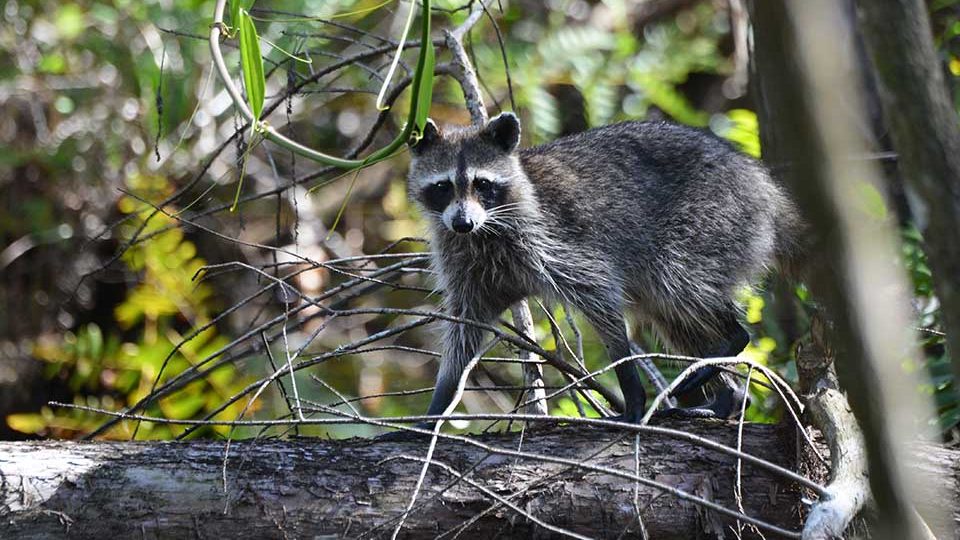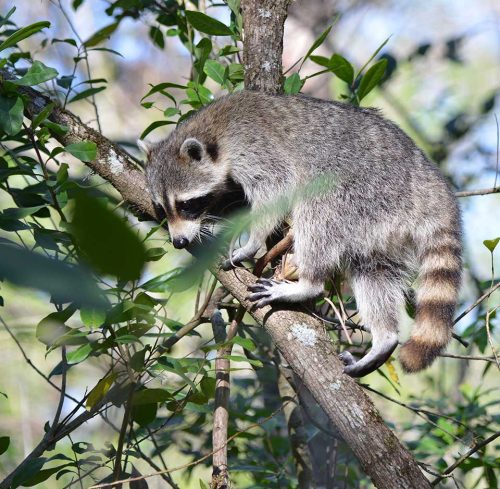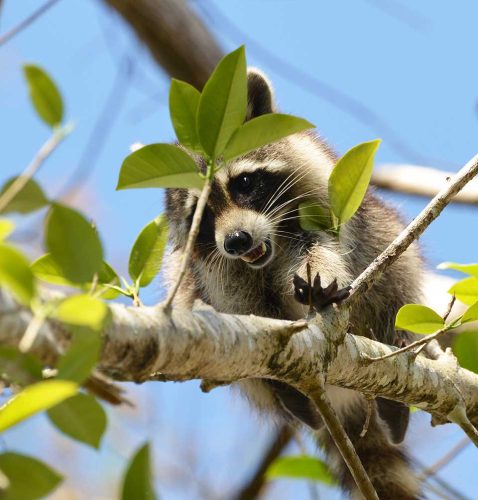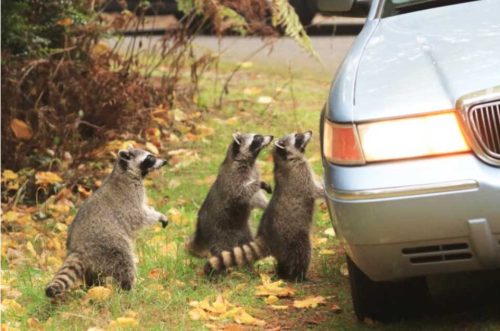Who Is That Masked Mammal?
With its trademark ringed tail, masked face, and sharp teeth, raccoons are best left in the wild—and with a wide berth.


I’ve had a complicated relationship with raccoons—or commonly called “coons.” You could call it one of both admiration and aversion, I suppose. This story is not for the soft-hearted.
In 1990, when hunting pheasant on the tidal meadows in Dennisville, my Brittany spaniel, Binx, flushed a raccoon instead of a pheasant out of the tall grasses along a marsh ditch. Binx had visions of capturing the raccoon but his chosen adversary was far too crafty for that. We tried to call Binx off the masked rival but he was committed to the conflict. The raccoon quickly swam into the watery ditch with Binx in pursuit. The coon turned, faced his opponent, and then crawled onto his head. Binx was defenseless in the water and in minutes he was drowned. The water was too cold and too deep for us to do anything but stand there in horror and disbelief.
It happened so fast. We thought to shoot, but with a shotgun our dog would have likely been shot as well. For those unfamiliar with them, a shotgun emits a spray of shot rather than a single projectile. In retrospect we needed to try to shoot the raccoon anyway but we didn’t realize then that it was our only choice.
We stood watching the still water in the ditch, looking helplessly at Binx’s watery grave. My eyes filled with tears and my heart was devastated by the death of our friend.
Afterward I heard that raccoons can even drown a horse. Their finger-like digits have great dexterity for gripping things and they can use them like hands. In the water they simply climb on their attacker’s head and hold on. Any animal without equal dexterity is a goner. I don’t fault raccoons; they are simply defending themselves. But I do respect a raccoon’s cunning. They are a formidable foe.
On another occasion our dogs were barking incessantly one evening. I went out to find a raccoon with a peanut butter jar stuck on its head. The brand was not one of ours, our trash cans have always been lidded, and our neighbors’ houses are not closeby. So this animal had been in this predicament for quite some time. I did not have the courage to try to rescue it, fearing its teeth and jaws. Recently a friend in a similar dilemma was able to remove the jar from the coon’s head, freeing it from its distress. I felt like a wuss, but I knew the power of a racoon and its sharp teeth and I couldn’t take the risk.
In my opinion raccoons are indeed one of the cutest creatures on the planet, but they are not known for their friendly disposition when push comes to shove, and they often harbor rabies. In fact that same Dennisville marsh on which Binx was killed was the site of a rabies vaccine trial bait program in the 1990s. Fishy green baits with a rabies vaccine were distributed by aerial broadcast.
On yet another occasion years ago, my college friends and I toured Europe and we visited the Barcelona Zoo. Now I will not admit to how this incident occurred, but I will confess to my frontal lobe not being fully developed in my late teens.

A watch I had inherited, my grandfather’s Rolex, not a cheap imitation and not a jeweled one either, is central to the story. I donned this watch on my travels. It had a clever movement that wound it when you moved your arms, which I did that day repeatedly, although without the watch, in order to attract a zookeeper’s attention to my predicament.
A raccoon was rinsing my watch in its pen, in close proximity to the tigers’ area. When I mimed to the keeper the mask of the raccoon, with my hands held to my eyes, he mistook it for a tiger’s eye rings. The chivalrous man had followed me swiftly down the walk but he markedly slowed his pace when he thought he was being led to the tiger’s lair. He was very relieved to discover it was a raccoon that was in possession of my family heirloom, and not a massive cat.
The raccoon repeatedly washed my watch and listened to its final movements. The zookeeper ran off and came back with a broom in his possession. Like a lion tamer with a chair he got the raccoon to surrender my timepiece. To this day I refuse to tell what led up to this embarrassment because in reality, I think you already know.
Now allow me to relay biologist Dennis Slate’s contention that it is a fallacy that raccoons wash their food before eating it. Evidently they use their sense of touch to identify food items. Since they are often eating by the water they appear to be washing their food, and in fact their scientific name is Procyon lotor, lotor meaning “washer.” I suspect my watch needed lots of close inspection before possible consumption. No matter, it never kept proper time after that.
Raccoons are one of the animals that habituate well to suburbia. As a result their numbers increase substantially in relation to the presence of people. Their population density is typically one raccoon in every 14 to 40 acres. But in suburbia their population can become very dense, as high as one raccoon per seven acres. This opens the door to lots of human/coon conflicts.
Their increased numbers present difficulties for other species as well, especially nesting birds and terrapin turtles. A raccoon can dig up innumerable terrapin egg clutches, destroying entire nesting sites by devouring all the eggs.
Once when checking a wood duck box on the meadow I was happy that we decided to tap on the box’s exterior with an oar before inspecting the contents. A raccoon ran out of the box, up the oar, and dropped into the water. Needless to say I now always tap on wood duck boxes before inspection; this practice has served me well.
As a child, I knew families who adopted raccoons as pets. They are curious, intelligent, and playful. But in the long run they are not only terrible pets but illegal ones as well. They are quite destructive and often increasingly ill-tempered as they age.

Raccoons do play an important role in the ecosystem as gardeners, pest control, and clean-up crew. They are great distributors of seeds. If you see a persimmon tree you likely have a raccoon to thank for it. They eat the fruit and pass the seeds that then germinate. A line of persimmons has often been attributed to a coon snacking on the fruit along a fallen dead tree trunk.
They also provide forage for coyotes, wolves, and large birds of prey, and juveniles are eaten by snakes.
Honestly, raccoons don’t get much good press because of the mischief they cause on farms and in human conflicts in suburbia. They are especially destructive in cornfields, consuming rows of the crop. Exterminators deal with raccoons on a regular basis because their contributions in people’s yards don’t seem to outweigh their potential damage and risks.
I’ve been long on story and short on particulars; thus I’m providing a sidebar of fast facts (see below).
Fast Facts
Appearance: Black mask across the eyes, bushy tail with four to 10 black rings. Adults weigh 4-22 lbs.
They can live up to 16 years in the wild and 21 in captivity. However, most don’t make it past their second year and those that do commonly live an average of 5 years. So in fact a coon’s lifespan is not all that long.
Raccoons prefer to den in trees but are extremely adaptable and will use abandoned ground burrows, rock crevices, fallen trees, and manmade structures.
They are omnivores, eating both plants and meat. Their diet consists of, but is not limited to, snails, salamanders, fish, snakes, frogs, mussels, crayfish, carrion, insects, tubers, seeds, grains, nuts, and fruit.
They are generally nocturnal.
Their native range is throughout most of the continental United States, southern Canada, Central America and northern South America.
In suburbia human refuse is a source of both food and conflict.
Their home range is typically 200 to 400 acres.
Females are sexually mature at two. They mate from January to mid-March with their litter born typically in April.
Typical litter size is two to seven kits.
Kits’ eyes remain closed for their first three weeks.
The kits are weaned at about 12 to 15 weeks and begin to venture out in a group with their mother.
In mid-September the family wanders more as individuals but stays within the mother’s home range. When winter approaches the family unit often reunites.
They spend most of the winter in a dormant state. It is not considered a hibernation because they maintain body temperature.








